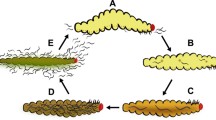Abstract
Host recognition by entomopathogenic nematodes may occur through contact with insects' excretory products, cuticle, or gut contents. We analyzed the behavioral responses of four species of entomopathogenic nematodes during contact with feces of natural or experimental hosts. Host recognition by nematodes was manifested in alterations in the frequency and/or duration of one or more search parameters including forward crawling, headwaving, body-waving, stopping, backward crawling, head-rubbing, and headthrusting.Heterorhabditis bacteriophora andSteinernema glaseri showed behavioral responses to contact with feces of their natural hosts,Spodoptera exigua (Lepidoptera) andPopillia japonica (Coleoptera), and to the experimental hosts,Acheata domesticus (Orthoptera) andBlatella germanica (Blatteria).Steinernema carpocapsae responded only toB. germanica feces, whereas5. scapterisci did not significantly respond to any of the insect species. During contact with cockroach feces, all nematodes, exceptS. scapterisci, showed avoidance behavior. We suggest that ammonia present in cockroach feces is inhibitory to nematodes. Specific host recognition by entomopathogenic nematodes may be an important mechanism to maintain host affinities.
Similar content being viewed by others
References
Bansch, R. 1966. On prey-seeking behavior of aphidophagous insects, pp. 123–128,in I. Hodek (ed.). Proceedings of the Prague Symposium on Ecology of Aphidophagous Insects. Academia, Prague.
Bell, W.J. 1991. Searching Behaviour: The Behavioural Ecology of Finding Resources (Animal Behaviour Series). Chapman and Hall, London.
Bell, W.J., andAdiyodi, K.G. 1981. The American Cockroach. Chapman and Hall, London.Bovien, P. 1937. Some types of association between nematodes and insects.Vidensk. Medd. Dan. Naturhist. Foren. Khobenhavn 101:1–114.
Byers, J.A., andPoinar, G.O., Jr. 1982. Location of insect hosts by the nematodeNeoplectana carpocapsae in response to temperature.Behavior 79:1–10.
Campbell, J.F., andGaugler, R. 1993. Nictation behavior and its ecological implications in entomopathogenic nematode search strategies.Behaviour In press.
Chandler, A.E.F. 1969. Locomorory behavior of first instar larvae ofAphidophagous syrphidae (Diptera) after contact with aphids.Anim. Behav. 17:673–678.
Croll, J. 1990. The Behavior of Nematodes: Their Activity, Senses and Responses. Edward Arnold, London.
Dusenberry, D.B. 1980. Behavior of free-living nematodes, pp. 127–158,in B.M. Zukerman (ed.). Nematodes as Biological Models. Academic Press, New York.
Dusenberry, D.B. 1983. Chemotactic behavior of nematodes.J. Nematol. 15:168–173.
Dutky, S.R., Thompson, J.V., andCantwell, G.E. 1964. A technique for the mass propagation of the DD-136 nematode.J. Insect Pathol. 6:417–422.
Evans, B.I., andO'Brian, W.J. 1986. An analysis of the feeding rate of white crappie.Develop. Environ. Biol. Fish. 7:200–306.
Gaugler, R. 1988. Ecological considerations in the biological control of soil-inhabiting insects with entomopathogenic nematodes.Agric. Ecosys. Environ. 24:351–360.
Gaugler, R., andKaya, H.K. 1990. Entomopathogenic Nematodes in Biological Control. CRC Press, Boca Raton, Florida.
Gaugler, R., Lebeck, L., Nakagaki, B., andBoush, G.M. 1980. Orientation of the entomo-pathogenic nematodeNeoaplectana carpocapsae to carbon dioxide.Environ. Entomol. 9:649–652.
Gaugler, R., Campbell, J.F., andMcGuire, T. 1990. Selection for host finding inSteinernema feltiae.J. Invertebr. Pathol. 54:363–372.
Granzer, M., andHaas, W. 1991. Host-finding and host recognition of infectiveAncylostoma caninum larvae.Int. J. Parasitol. 21:429–440.
Green, C.D. 1980. Nematode sex attractants.Helminthol. Abstr. 49B:81–93.
Grewal, P.S. 1990. Studies on saprobic rhabditid nematodes and their associated bacteria affecting mushroom culture. PhD thesis. University of London.
Grewal, P.S.,Gaugler, R.,Kaya, H.K., andWusaty, M. 1993a. Infectivity of the entomo-pathogenic nematodeSteinernema scapterisci (Nematoda: Steinernematidae).J. Invertebr. Pathol. In press.
Grewal, P.S.,Gaugler, R., andLewis, E.E. 1993b. Host recognition behavior of entomo-pathogenic nematodes during contact with gut contents.J. Parasitol. 77:In press.
Grundler, F., Schnibbe, L., andWyss, U. 1991. In vitro studies on the behavior of second-stage juveniles ofHeterodera schachtii (Nematoda: Heteroderidae) in response to host plant root exudates.Parasitology 103:149–155.
Ishibashi, N., andKondo, E. 1990. Behavior of infective juveniles, pp. 139–150,in R. Gaugler and H.K. Kaya (eds.). Entomopathogenic Nematodes in Biological Control. CRC Press, Boca Raton, Florida.
Kaya, H.K. 1990. Soil ecology, pp. 93–117,in R. Gaugler and H.K. Kaya (eds.). Entomopath-ogenic Nematodes in Biological Control. CRC Press, Boca Raton, Florida.
Lewis, E.E., Gaugler, R., andHarrison, R. 1992. Entomopathogenic nematode host finding: Response to host contact cues by cruise and ambush foragers.Parasitology 105:309–315.
Mullins, D.E., andCochran, D.G. 1973. Nitrogenous excretory materials from the American cockroach.J. Insect Physiol. 19:1007–1018.
Nyugen, K.B., andSmart, G.C., Jr. 1990.Steinernema scapterisci n. sp. (Rhabditida: Steiner-nematidae).J. Nematol. 22:187–199.
Oser, B.L. 1954. Hawk's Physiological Chemistry, 14th ed. McGraw-Hill, New York.
Poinar, G.O., Jr. 1979. Nematodes for Biological Control of Insects. CRC Press, Boca Raton, Florida.
Poinar, G.O., Jr. 1990. Taxonomy and biology of Steinernematidae and Heterorhabditidae, pp. 23–61,in R. Gaugler and H.K. Kaya (eds.). Entomopathogenic Nematodes in Biological Control. CRC Press, Boca Raton, Florida.
Pye, A.E., andBurman, M. 1981.Neoaplectana carpocapsae: Nematode accumulations on chem-ical and bacterial gradients.Exp. Parasitol. 51:13–20.
SASInstitute. 1982. SAS User's Guide: Statistics. SAS Institute, Cary, North Carolina.
Schmidt, J., andAll, J.N. 1978. Chemical attractionof Neoaplectana carpocapsae (Nematoda: Steinernematidae) to insect larvae.Environ. Entomol. 7:605–607.
Schmidt, J., andAll, J.N. 1979. Attraction ofNeoaplectana carpocapsae (Nematoda: Steiner-nematidae) to common excretory products of insects.Environ. Entomol. 8:55–61.
Stewart, G.L., Despommier, D.D., Burnham, J., andRaines, K.M. 1987.Trichinella spiralis: Behavior, structure, and biochemistry of larvae following exposure to components of the host enteric environment.Exp. Parasitol. 63:195–204.
Webster, J.M., andDunphy, G.B. 1988. Host compatibility of insects to nematodes, pp. 237–245,in J.A. Veech and D.W. Dickson (eds.). Vistas on Nematology: A Commemoration of the Twenty-fifth Anniversary of the Society of Nematologists. Society of Nematologists, Inc., Hyattsville, Maryland.
Wharton, D.A. 1986. A Functional Biology of Nematodes. The Johns Hopkins University Press, Baltimore, Maryland.
Zervos, S., andWebster, J.M. 1989. Susceptibility of cockroachPerilaneta americana toHet-erorhabditis heliothidis (Nematoda: Rhabditoidea) in the laboratory.Can. J. Zool. 67:1609–1611.
Author information
Authors and Affiliations
Rights and permissions
About this article
Cite this article
Grewal, P.S., Gaugler, R. & Selvan, S. Host recognition by entomopathogenic nematodes: Behavioral response to contact with host feces. J Chem Ecol 19, 1219–1231 (1993). https://doi.org/10.1007/BF00987382
Received:
Accepted:
Issue Date:
DOI: https://doi.org/10.1007/BF00987382




